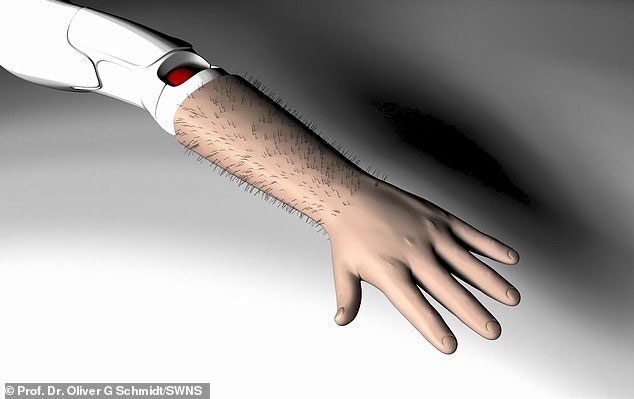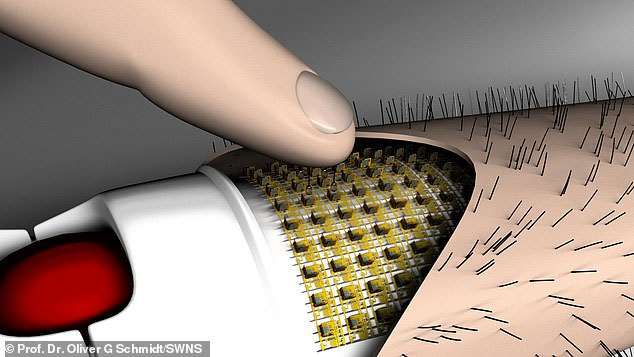Scientists develop electronic skin that integrates artificial hair identical to human skin
Recently, scientists have made a big step in the development of electronic skin integrated with artificial hair.

Image simulates electronic skin with artificial hairs attached.
According to the Daily Mail (UK), while previously developed electronic skins lack the natural tactile ability, a team at Chemnitz University of Technology (Germany) has begun to develop an electric skin. particles with special artificial hairs. This type of artificial hair is attached to the skin, allowing people to touch it naturally, feel many different states of the skin such as rough, smooth.
Lead author Christian Becker said: 'Our approach enables spatially precise alignment of functional sensing molecules in 3D. This technology can be mass-produced in parallel processes'.

The new technology uses an anisotropic magnetoresistance (AMR) sensing system, which can accurately identify magnetic changes. ARM is often used as a sensor in cars to determine the position and speed of the vehicle.
The researchers used a 'micro origami process' to fold these sensors into 3D structures, allowing multiple sensors to be integrated in a small space. The 3D micro origami structure is then integrated into a single active matrix. Here, each individual AMR sensor can be decoded by a microelectronic circuit.
Dr Daniil Karnaushenko, co-author of the study, said: 'Combining active magnetic sensors with automated micro origami processes is a completely new approach to miniaturization and integration of sensing systems. high resolution 3D variables'.
The team integrated this sensor system with magnetic hairs into an electronic skin made from an elastomeric material. When humans touch these hairs, sensors underneath can record their movements, as well as their exact direction of movement, just like on real human skin.
The researchers believe that this new type of electronic skin could be used in many important future applications. For example, it could be used to replace human skin or to develop medical sensors in the body. In addition, the new invention can help humanoid robots become more realistic, able to interact with human senses.

The electronic skin integrated with artificial hair is made by an anisotropic reluctance (AMR) sensing system (yellow image). (Photo: Daily Mail)

(Photo: Daily Mail)

Sensor system underneath the electronic skin. (Photo: Daily Mail)
- Artificial skin has hair and sweat glands
- Israel invented electronic skin that can heal itself
- Human skin was born
- Manufacturing 'electronic leather'
- Scientists have developed artificial skin that feels like real leather
- Artificial leather for human robot
- 'Planting' ... human skin in the laboratory
- Artificial skin feels real
- Successfully studied electronic skin to help disguise as gecko
- Inventing electronic skin can display heart rate information on your hands
- Artificial hair follicles help treat hair loss
- Artificial leather bulletproof
 The US company is about to build a supersonic passenger plane of 6,000km / h
The US company is about to build a supersonic passenger plane of 6,000km / h Japan develops avatar robot as in fiction film
Japan develops avatar robot as in fiction film Australia tested the world's first mango picking robot
Australia tested the world's first mango picking robot America develops technology to separate water from animal waste
America develops technology to separate water from animal waste